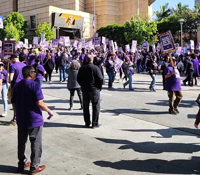
Peter Drier and Joan Ling presenting the findings of the first ULA report. Photo by Brenda Verano
When it was first introduced, supporters of Measure ULA, also known as the “Mansion Tax,” expected and told voters that the collected revenue generated by the tax would be approximately $600 million to $1.1 billion annually. Those projections, however, have fallen short. As of today, Measure ULA has collected and raised $215 million since taking effect.
Despite coming far below the initial projection, Joe Donlin, president of United to House LA, says this amount is still outstanding and something to be celebrated.
“Measure ULA has raised $215 million today. If anyone tries to say that's some sort of failure, they’re out of their mind. This has already proven to be one of the greatest sources of affordable housing revenue the City of L.A. has ever seen,” Donlin said.
The beginning of this month marked the anniversary of the implementation of Measure ULA, which collects a one-time real estate transfer tax of 4% on properties in Los Angeles sold for $5 million or more and a 5.5% tax on properties selling for $10 million or more.
The revenue collected by ULA is then invested and allocated to housing rights issues impacting many Los Angeles constituencies, including the Latino community, such as homelessness prevention, tenant protection and affordable housing.
To celebrate and applaud the milestone of the measure, housing rights advocates, renters, city leaders, researchers and housing developers gathered last Thursday to celebrate what they referred to as “ULA’s birthday” at the Santa Monica/Vermont Metro Plaza.
The event took place adjacent to the construction site of the Santa Monica Vermont Apartments. It is an affordable unit funded by Measure ULA, expected to house low-income families or those at risk of falling into homelessness in four months.
BACKGROUND
In 2019, a coalition of over 240 organizations known as United to House LA (UHLA) came together.
UHLA, which included community-based organizations, labor unions, affordable housing developers, tenant rights groups, community land trusts, homelessness service providers and others, drafted the ballot measure called the “Los Angeles Program to Prevent Homelessness and Fund Affordable Housing (House LA),” which later became known as “Measure ULA” on the ballot. Before going to the ballot, UHLA had to file the measure in January 2022 and gather signatures to qualify the measure in May 2022, which is when the organizing efforts began to inform people about the measure and execute a campaign that would lead to the passing of the measure.
The measure was voted in on the November 2022 election, approved with 58% of the votes. It went into effect on April 1, 2023.

Joe Donlin, Director of United to House LA at Thursday's event. Photo by Brenda Verano
Measure ULA was introduced to L.A. residents in hopes of combating the cities and counties' overwhelming housing unaffordability and homelessness crisis. The latest homeless count in L.A. indicated that homelessness continues to rise dramatically and rapidly and Latinos are among the most vulnerable populations.
According to the 2023 Greater Los Angeles Homeless Count, homelessness rose by 9% on any given night in Los Angeles County to an estimated 75,518 people and by 10% in the City of Los Angeles to an estimated 46,260 people. When it comes to Latinos, the same data showed they make up 43% of the county’s homeless population, a substantial increment from the 2022 count.
Councilmember Hugo Soto-Martinez of District 13 echoed the need for support to house the most vulnerable people and said this measure is doing just that.
“Our city is at an unprecedented time, having an unprecedented housing crisis and that means that we need to act with the urgency that this issue deserves,” said Soto-Martinez. “We know that over 60% of Angelenos are renters, and here in District 13, that is over 80%. We know that three quarters of the renters of the city are rent burdened, meaning that they spend more than 30 percent of their income on rent, and for the Latino community, it is over 60 percent.”
THE REPORT
The event was also put together to officially present a report released on Thursday titled “Measuring LA’s Mansion Tax: An Evaluation of Measure ULA’s First Year” by researchers at UCLA, Occidental College and USC.
The 36-page report found that ULA funds are expediting the construction of 795 affordable housing units, including 331 supportive housing units. According to the report, Measure ULA allocates at least 5% of its program funding to rental assistance to keep tenants housed who are at risk of losing their homes due to economic thresholds. The Short-Term Emergency Assistance Program, also known as the ULA Emergency Rental Assistance Program (ULA ERAP), was allocated $30 million as part of the first year’s expenditure plan.
According to the LA Housing Department, as of March 11, 2024, ULA ERAP has approved 4,652 tenant households, representing an estimated 11,000 Angelenos, for a total of $24 million in emergency rental assistance, stabilizing families and likely preventing thousands of evictions. 30% of the rental assistance payments thus far have gone to Latino households. Joan Ling, a researcher from UCLA and co-author of the ULA report, said that over 31,000 applications were submitted last fall when the ULA ERAP application portal opened.In addition, according to researchers, for every $1 of ULA funding for affordable housing projects, the city has received $10 from the state, federal and private funding, for a total of $514.8 million.
The report also showed that by providing a consistent funding source for SHLA, Measure ULA, has helped many Angelinos stay housed in 2023. With the funding, SHLA has provided full legal representation to 1,262 LA tenants in their eviction cases and legal advice to 3,387 tenants. Of the tenants who were fully represented, half were able to stay in their homes, while 40% were able to negotiate a “soft landing” to prevent homelessness, including waiving rental debt, relocation expenses and extra time to move out. In addition, 10%t of tenants received additional assistance with enforcing specific tenant rights. Further, community-based organizations connected with over 400,000 tenants across L.A. County, including 160,000 in the City of L.A., through calls, texts, and in-person outreach and held 400 workshops to educate tenants about their rights.
JOBS
The report also found that Measure LA has also created career paths and job creations that provide a liveable wage and are unionized. “All affordable housing production of buildings with 40 units or more that receive ULA funding are built under a Project Labor Agreement (PLA) that guarantees union labor standards on the job. ULA’s first affordable housing effort—called ‘Accelerator Plus’ and part of the Multifamily Affordable Housing program outlined in the measure— proposes to fund the construction of 795 units of affordable housing at nine sites across the city,” stated the report.
According to the report, the total funding and number of construction jobs created will grow significantly and be beneficial to local residents, who are the ones working in the construction of many of the affordable housing units.Anne-Marie Otey, who oversees the Los Angeles and Orange County Building Trades, made up of 150, 000 skilled men and women in 48 local unions, was also present at Thursday’s event. “ULA projects will follow union wages, training, and safety standards. That is a huge difference from the majority of residential construction, where workers are paid minimum wage, sometimes paid in cash, sometimes not paid at all and they're exposed to huge safety hazards. They are risking their lives to put food on the table,” Otey said. “We bring in people from challenging backgrounds. Some of them, honestly, have never had a job before. But we treat them with respect. We welcome them to our union family. We enroll them in our apprenticeships, and they're working here.”

Supporters and advocates of ULA in Thursday's press conference. Photo by Brenda Verano
However, criticism and opponents of Measure ULA continue to rise. Experts say the continuous lawsuits, tactics against the measure and the actions of some real estate companies are the reasons why the expected $1 billion in revenue has fallen short. A false narrative and criticism against ULA began early on during the campaign process for the measure, when the real estate industry’s propaganda wrongly described Measure ULA as “the largest property tax increase in L.A. history.” Measure ULA is not a property tax, which is an annual assessment of all property that is allocated for government functions; instead, it is a one-time tax on high-priced property sales that helps low-income people afford housing.
The UCLA, Occidental College and USC report also cited several celebrities who, to avoid this tax, began selling their mansions before the ULA measure took effect. Some of these celebrities include celebrity plastic surgeon and “Botched” star Paul Nassif, who offered a $1 million bonus to any agent who could sell his $28 million Bel-Air mansion before April 1, as well as actor Brad Pitt, who sold a home for $33 million and Mark Wahlberg, who sold his mansion for $55 million.
“As a result, L.A. saw a significant spike in sales of such properties just before Measure ULA went into effect, the first quarter of 2023… Real estate transactions over $5 million accounted for 3–7% of all transactions. However, in the first quarter of 2023, transactions over $5 million doubled to 12% of all transactions,” as stated in the report.
“In the quarter, in the months prior to the implementation of ULA on April 1st, 2023, there was a rush to sell off high-value real estate, to the point where the amount of sales of properties over $5 million tripled compared to the year prior,” Ling said. “These investors eliminated $270 million of ULA tax that would have gone into the pot to support more tenants, and more affordable housing.”
Just six months ago, in October 2023, a Los Angeles County judge dismissed a lawsuit filed by the Howard Jarvis Taxpayers Association, the Apartment Association of Greater Los Angeles and Newcastle Courtyards, which argued the measure was unconstitutional. More recently, a statewide ballot initiative has been one of the latest threats against Measure LA. The “Taxpayer Protection and Government Accountability Act,” which has been qualified for the November 2024 ballot, would repeal ULA and discard the ability of state and local governments to implement taxes necessary to support public infrastructure and services. The “Taxpayer Protection and Government Accountability Act” is led by the California Business Roundtable (CBRT).
“There's been many attempts by big real estate industry to try to undermine ULA, [to] try to undermine important funding for rental assistance and for affordable housing,” Dolin said. “We've defeated them at every step of the path, and we're going to keep winning. “
To read the full report of Measure ULA, visit:www.oxy.edu/ULA.














(0) comments
Welcome to the discussion.
Log In
Keep it Clean. Please avoid obscene, vulgar, lewd, racist or sexually-oriented language.
PLEASE TURN OFF YOUR CAPS LOCK.
Don't Threaten. Threats of harming another person will not be tolerated.
Be Truthful. Don't knowingly lie about anyone or anything.
Be Nice. No racism, sexism or any sort of -ism that is degrading to another person.
Be Proactive. Use the 'Report' link on each comment to let us know of abusive posts.
Share with Us. We'd love to hear eyewitness accounts, the history behind an article.